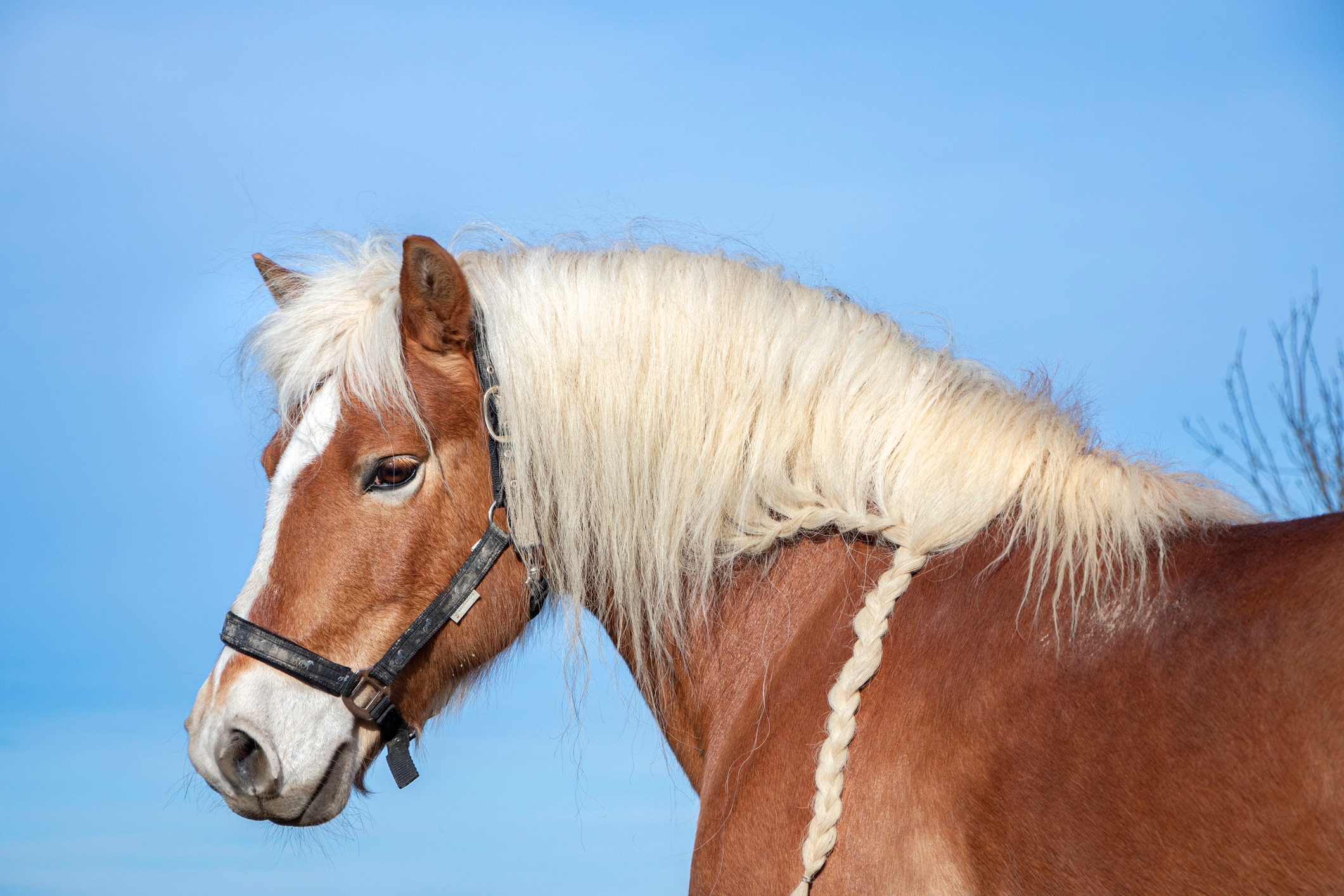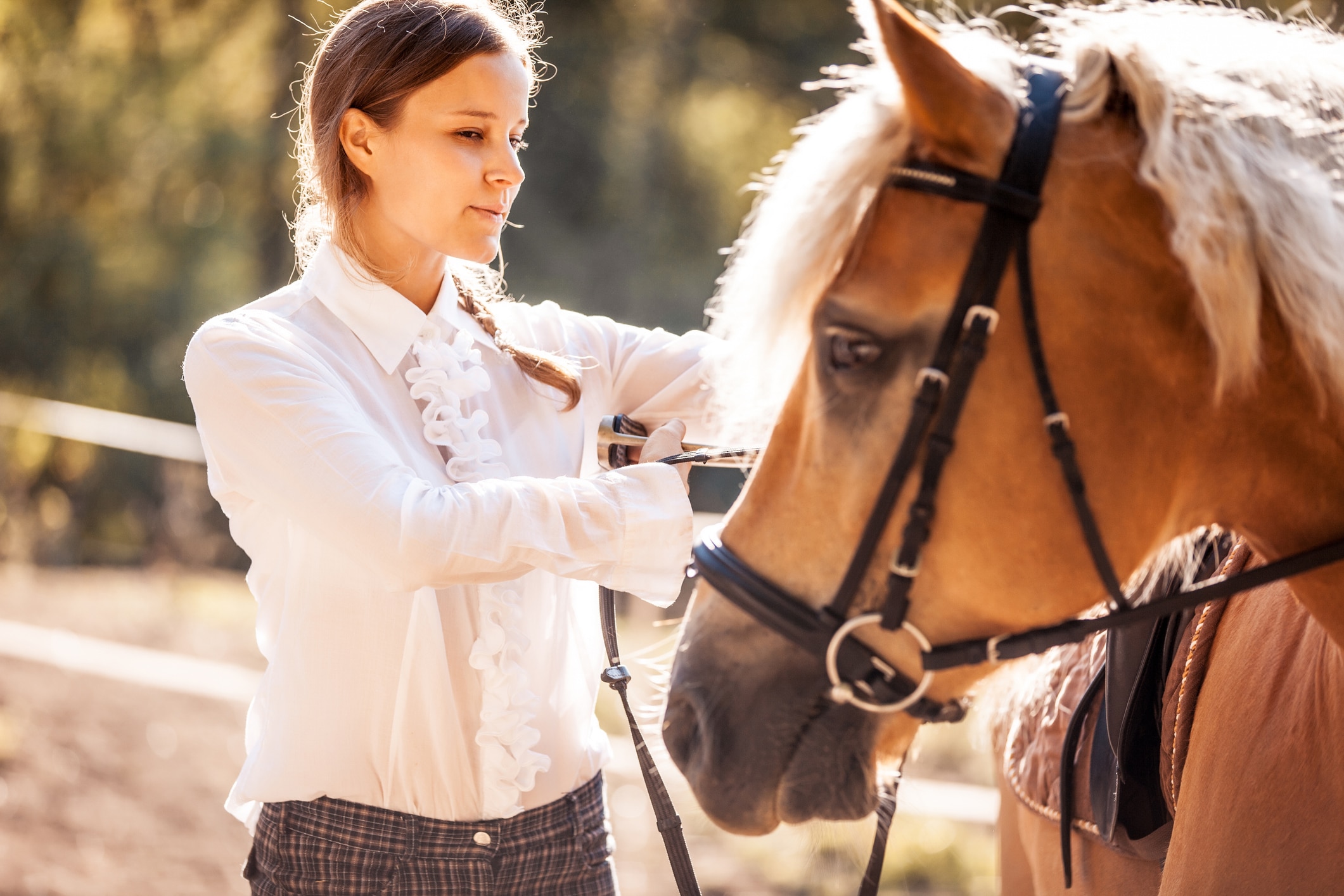Haflinger
BiancaGrueneberg/iStock / Getty Images Plus via Getty Images
The Haflinger horse breed dates to 1874, with the birth of a stallion named Folie in the village of Hafling in the South Tyrolean Mountains of Italy and Austria. Because of the breed’s short stature, some might mistakenly refer to them as ponies, even though they are horses.
Known for their chestnut coat, Haflingers are dependable, intelligent, gentle, and friendly, making them lovely equine companions for children and adults alike.
Haflinger Horse Snapshot
-
Height: 13.5 to 15 hands (54 to 60 inches)
-
Weight: 800 to 1,300 pounds
-
Lifespan: 25 to 30 years
-
Colors: Shades of chestnut with a pale mane; tail can be flaxen or white
Caring for a Haflinger Horse
The Haflinger horse is not considered a high-maintenance breed. There are a few health concerns to be aware of, including those that are genetically inherited. Also, a pretty Haflinger horse that sports a pale coat can require more effort in terms of grooming to keep the coat clean and shiny.
Haflinger horses are known for their endearing personality and intelligence. They can be trained in a variety of disciplines and can work with riders of all ages and experience levels. They’re versatile and do well as family pets, therapy horses, work horses, and competitive horses.

Haflinger Horse Health Issues
The Haflinger horse breed is generally healthy and strong. They mature slowly, and some of these horses even live into their 40s.
Haflingers are hardy, thanks to the mountainous environment they were bred in, and they are capable of working for many years. However, they can develop the following health concerns.
Equine Degenerative Myeloencephalopathy (EDM)
Equine degenerative myeloencephalopathy (EDM) is a genetic disorder that affects several equine breeds, including the Haflinger. This neurologic disease is progressive, causing damage to the neurons, axons, and myelin in the spinal cord and brainstem. Neurons are building blocks to the nervous system that send and receive messages throughout the body. Each neuron consists of an axon, dendrite, and cell body. The axon is the long, tail-like structure of the neuron and transmits the signals. Myelin is a fatty substance that surrounds the axons and helps with electrical signaling.
Symptoms of EDM typically develop in a horse at 6 months to 24 months of age., but some cases may not develop until 5–10 years of age. They experience weakness in every leg and ataxia (impaired balance and coordination). These horses often appear to be uncoordinated, like they do not know where to put their feet.
Vitamin E deficiency might play a role. Vitamin E is an antioxidant that helps maintain normal neurologic function to the body by. Therefore, supplementation may be helpful in slowing the progression of symptoms after they’ve developed.
Giving vitamin E to pregnant mares and newborn foals that might be at risk of this disease is a preventative step worth discussing with your veterinarian, as is providing young horses and mares with access to lush pasture. Work with a veterinarian to give your horse proper care.
Equine Metabolic Syndrome (EMS)
Equine metabolic syndrome (EMS) is when the body can’t process insulin properly. It affects many breeds, including those that are hardy like the Haflinger because of their tendency to store fat.
Symptoms of EMS in horses include:
-
Weight gain
-
Obesity
-
Difficulty losing weight
-
Fat deposits on neck and tailhead
EMS can lead to other serious problems, such as laminitis, so take steps to prevent it and treat it promptly if the condition develops. Your veterinarian can help you come up with a diet and weight loss plan for your horse, and they can provide guidance on how to manage this lifelong condition.
Ocular Squamous Cell Carcinoma (SCC)
Ocular squamous cell carcinoma is one of a few types of squamous cell carcinoma. It is the most common type and can develop in the limbus junction of the cornea and sclera of the eye, eyelid, and third eyelid of the eye.
Horses like the Haflinger that have light pigmentation in the eye area are at risk. Studies have also found that Haflingers can be genetically predisposed to SCC, and these horses can develop it at a younger age. Genetic testing can reveal if your horse is at greater risk.
Exposure to UV light can increase the odds of your horse developing ocular SCC as well, so protecting them from UV rays with a fly mask can be a preventative measure.
Because this cancer causes eye tumors, symptoms include squinting and excessive tearing. Your horse might also try to prevent you from going near the affected eye. Over time, if left untreated, the cancer can spread into the surrounding eye tissue and lead to vision loss, and the disease can be fatal.
Polysaccharide Storage Myopathy (PSSM)
Polysaccharide storage myopathy (PSSM) causes the body to accumulate too much glycogen (sugar) in the muscles, leading to painful cramps. This is referred to as “tying up.”
Type 1 PSSM is caused by a genetic mutation, and the Haflinger horse is one breed that can be genetically predisposed to PSSM.
Symptoms of PSSM in horses include:
-
Muscle cramping or tremors
-
Soreness
-
Stiffness
-
Weakness
-
Muscles that feel hard or firm
-
Sweating
-
Reluctance to move or lie down
-
Lameness
-
Inability to stand
Stall rest, anti-inflammatory medications, IV fluids, and muscle relaxants may be prescribed by your veterinarian if your horse experiences a tying up episode. Changes to your horse’s diet, such as reducing their sugar intake by taking them off grass or changing their grain, may be recommended by your veterinarian to help manage the disease.
Once your horse recovers, you can work with your vet to use diet and exercise to prevent future episodes.
What To Feed a Haflinger Horse
Haflinger horses are considered easy keepers, meaning they gain weight easily. They also don’t need as much food as some other equine breeds.
Figuring out the right amount of food to give your Haflinger is a key component to helping them maintain a healthy weight. And the right diet can help prevent health problems that could arise from being overweight or obese.
A diet consisting of forage with low starch may be beneficial for most Haflingers. For Haflingers that have higher energy needs, they may need an added fat in their diet. It is best to work with your veterinarian on the nutritional needs of your individual horse and their lifestyle.
Work with your vet to determine the appropriate food and portion sizes for your Haflinger horse. The general rule is to provide 2% of their body weight in forage every day, but this should be adjusted to suit your horse’s needs.
Monitor your horse’s body condition score in addition to their weight. That way, if you notice weight gain, you can act right away to help your Haflinger lose the extra pounds in a safe and healthy manner.
Haflinger Horse Disciplines
Haflingers were bred to work as packhorses. They are strong and athletic and can be used for a range of purposes, including work, riding, and equestrian sports.
Here are some of the many areas where they can excel:
-
Light draft and harness work
-
Various types of riding, including therapeutic
-
Jumping
-
Vaulting
-
Driving
-
Dressage
-
Endurance
-
Eventing
Because of the Haflinger horse’s size, smaller adults might find them more comfortable to ride than larger horses.

Haflinger Horse Personality and Temperament
Haflinger horses have a wonderful temperament and are eager to work. They make great companions for families and individuals. Also, because they are friendly and calm, they are ideal horses for equine-assisted therapy.
Haflingers enjoy being around people; they are curious, easygoing, and gentle. Riders of all experience levels, including children, young riders, and beginners, are likely to find the Haflinger enjoyable to work with.
Haflingers are dependable, intelligent, gentle, and friendly, making them lovely equine companions for children and adults alike.
Haflinger Horse Training
Haflingers are kind, quiet, and intelligent horses that are adaptable and can learn commands quickly. Plus, they aren’t easily spooked.
These traits make them easier to train, but it’s important to bear in mind that every horse is an individual with a distinctive personality.
Spend time with your horse so you can bond with them and get to know them. Use positive, gentle training methods and be patient. Training these horses properly can help ensure their best traits will shine through.
Haflinger Horse Grooming Guide
Haflinger horse colors can range from light gold to dark chestnut or liver. If your horse’s coat is a lighter shade, keeping it clean might be a bit more of a challenge compared to a darker Haflinger horse. A white or flaxen mane and tail can also be harder to keep clean compared to darker hair.
All Haflingers have a thick mane, but a lot of them also have a double mane that will fall onto both sides of the neck. This trait might make grooming somewhat more time-consuming.
Besides that, the grooming needs of this breed aren’t extensive or complicated. A standard horse grooming kit should give you what you need to maintain your horse’s skin and coat in good condition.
Coat Care
Groom your Haflinger often—at least several times a week—to remove dirt, debris, mud, and loose hair from the coat. Use various brushes (e.g., curry comb, dandy brush, finishing brush) on the body, and use a soft cloth to gently clean delicate areas on the face.
To keep your horse’s thick mane and forelock looking beautiful, brush them carefully, and use a conditioning detangler to make it easier to smooth the hair without pulling on it and damaging it. The same can be done for this horse’s thick tail.
Hoof Care
All horses should have their hooves examined and cleaned daily with a high-quality hoof pick to be sure they aren’t developing injuries or infections. Working with a farrier is important, as this will ensure your horse’s hooves are healthy, balanced, and trimmed/shod appropriately.
Haflinger Horse FAQs
Are Haflinger horses good for beginners?
Haflinger horses are a great breed for beginners, including children. These gentle horses are steady and friendly, and their smaller size can make them more comfortable for those who are new to riding.
Can Haflingers carry adults?
Haflingers can be ridden by adults. They are strong, capable, and suitable for riders of all experience levels.
Are Haflingers draft horses?
The Haflinger is not a draft horse. This is a warmblood breed that was developed to be a light working horse.
How much does a Haflinger cost?
The price of a horse will vary based on factors like their age, bloodline, and level of training. Some Haflinger horses might cost around $3,500, while others might be $10,000 or more.
